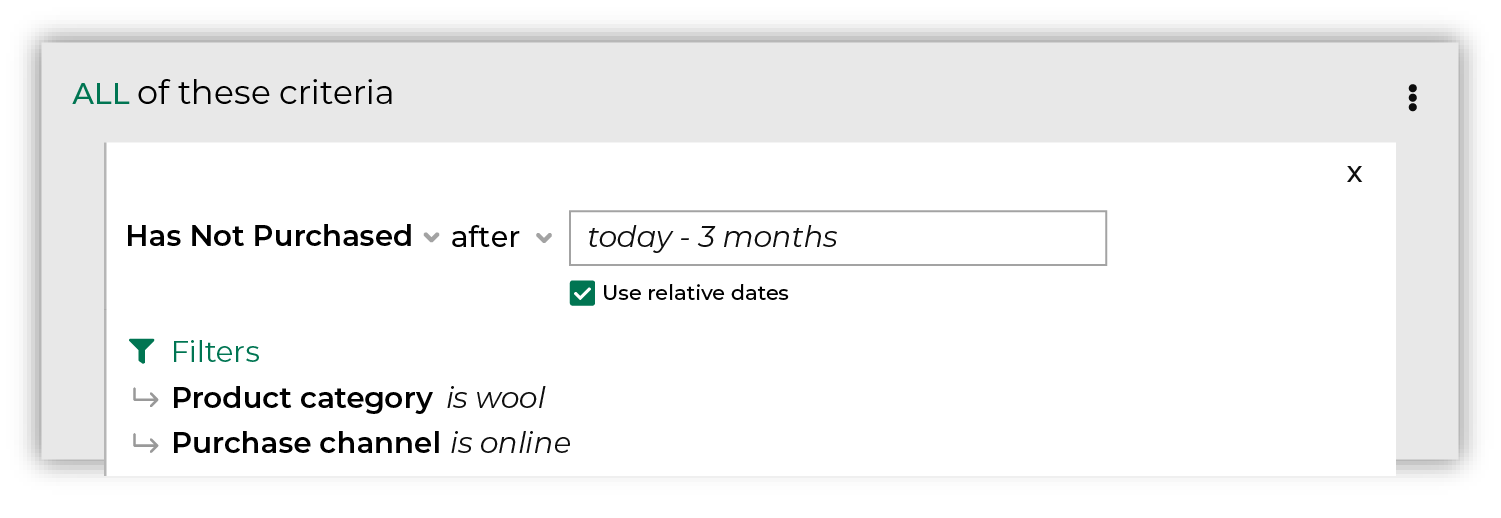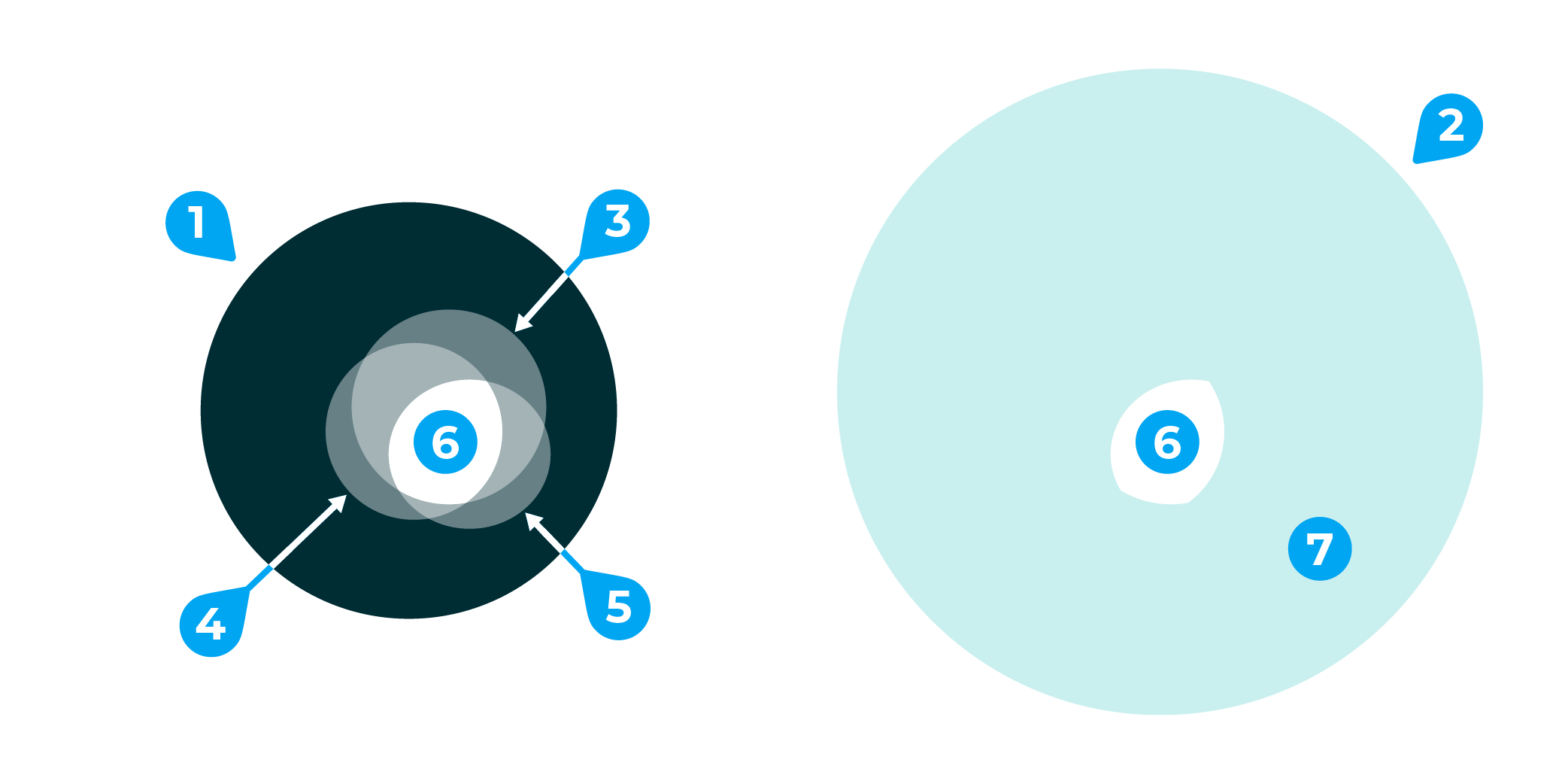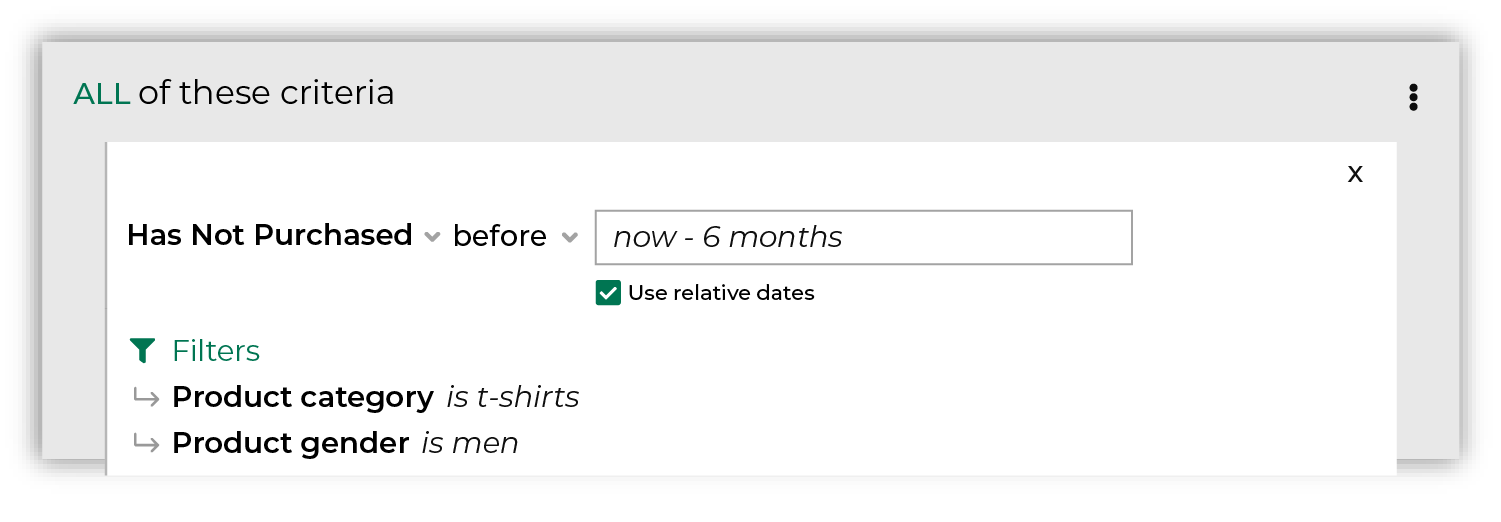Has not purchased¶
Has Not Purchased returns all orders that occurred during your chosen date range, and then identifies all of your customers that did not make a purchase within that date range. For example, return all customers who have not purchased within the previous 3 months:

After you specify a date range you may apply filters to focus in on specific products, brands, channels, and stores, i.e. “who hasn’t purchased a specific product by a specific brand from a specific channel or store.” For example, return a list of customers who have not purchased a wool product online during the previous 3 months.
Tip
As you add filters to this attribute, the number of customer records that is returned gets larger.
Consider all of your brands and all of the products in your product catalog and all of your stores and your website. Consider the percentage of all of your customers who may have purchased within any time window. And then consider the number of customers you have in your Customer 360.
For example, let’s say you have 1,000,000 customers in your Customer 360. If you configure Has Not Purchased to return only customers who purchased last month, that might be 8,000 customers.
Has Not Purchased compares the list of customers who did purchase to your total list of customers, and then returns the difference. In this example that difference is 992,000 customers.
What are purchase behaviors?
Purchase behaviors are a feature of Amperity that are built on top of standard output for transactions (purchases and items). Purchase behaviors require standardized product catalog field names to be present in your standard output for transactions.
Use purchase behaviors in segments to return a list of customers, and then filter that list of customers by any combination of brand, channel, individual items in your product catalog, and store.
Purchase behaviors are available for first purchase, has not purchased, has purchased, most frequent order, repeat purchase, and total value of orders.
How has not purchased works¶
Has Not Purchased represents a common approach people use when they build segments: which of my customers have not purchased, and then associate that list of customers to your products and brands.
Has Not Purchased is a compound attribute, which means that it’s built from a combination of attributes that already exist in your data, and then appears as a single attribute that you can choose from the Segment Editor.
With this attribute, you can focus less on SQL and more on finding answers that align to your marketing goals and strategies. Purchase behavior attributes simplify the number of steps that are required to associate a list of customers to your products, stores, channels, and brands.
The following diagram shows how Has Not Purchased works:

The numbers in this diagram represent:
The Unified Itemized Transactions table, or the table that associates all of the items you sold with the order ID of the transaction and the customers who purchased them.
The Merged Customers table, or the table in which all of your customers are located and the foundation of your customer 360 database.
A purchase channel.
A product category.
A product gender.
All of the customers who purchased, inclusive of purchase channel (3), product category (4), and product gender (5).
All of the customers who did not purchase, and also the list of customers that is returned by Has Not Purchased during the date range that you choose.
Tip
For more information about how Has Not Purchased works, including an explanation of the SQL that runs behind the Segment Editor, review the Has not purchased topic in the Amperity A-Z reference.
Why does the audience get larger?¶
As you add filters to Has Not Purchased the size of the audience that is returned from the Merged Customers table gets larger. The best way to explain this is to use a series of diagrams.
This series of diagrams steps through and shows you why your audience gets larger as you apply more filters. On the left side is the Unified Itemized Transactions table and on the right side is the Merged Customers table.
The following diagram shows just one filter (the white inner circle). Let’s say that filter is purchase channel and that you chose “online”:

The results of Has Not Purchased will return “all of your customers who did not purchase from your website.”
The following diagram shows a second filter. Let’s say this one adds product category and that you chose “shirts”:

The results from the Unified Itemized Transactions table is smaller because only purchases that exist in both filters are returned. This means the results for Has Not Purchased will be larger, and now return “all of your customers who did not purchase a shirt from your website.”
The following diagram shows a third filter. Let’s say this one adds product gender and that you chose “F”:

The results from the Unified Itemized Transactions table is now much smaller and the results for Has Not Purchased have grown larger, and now return “all of your customers who did not purchase a women’s shirt from your website.”
Use has not purchased in a segment¶
You can add the Has not purchased purchase behavior to a segment from the Segment Editor. Click Add condition, choose Purchase behaviors, and then select Has not purchased.

After the Has not purchased purchase behavior attribute has been added, select an operator, and then finish defining the conditions for how this attribute should be applied to the segment.
Example: Who has not purchased t-shirts?¶
The following example uses Has Not Purchased to return a list of customers who have not purchased a men’s t-shirt in the previous six months:

Available conditions¶
The following table lists the operators that are available to this attribute.
Note
Recommended operators for this attribute are identified with “ More useful” and operators with more limited use cases are identified with “ Less useful”.
Condition |
Description |
|---|---|
after |
More useful Returns a list of customers who have not purchased after the specified time window. |
before |
More useful Returns a list of customers who have not purchased before the specified time window. |
between |
More useful Returns a list of customers who have not purchased between two specified time windows. |
not between |
Returns a list of customers who have not made a purchase outside the dates that define the specified time window. For example, if you want to find customers who only purchased school supplies in the two weeks prior to the start of school, and if school started on 9/7, you could define the start of the time window as 8/24 and the end of the time window as 9/6, the not between condition will ensure that only customers who purchased within that time window will be returned. |
not on |
Less useful Returns a list of customers who made a purchase on the specified date. |
on |
Returns a list of customers who have not purchased on the specified date. |
Filter attributes¶
A filter attribute is a standard column that is output by Amperity and is available from the Unified Itemized Transactions table. When a filter attribute is associated with a purchase behavior attribute, you may use them to filter the results by specific items in your product catalog, such as by brand, by channel, by store, or by specific details about the items in your product catalog, such as color, SKU, and so on. The list of filter attributes that will be available for product catalogs depends on their availability within your Unified Itemized Transactions table.
